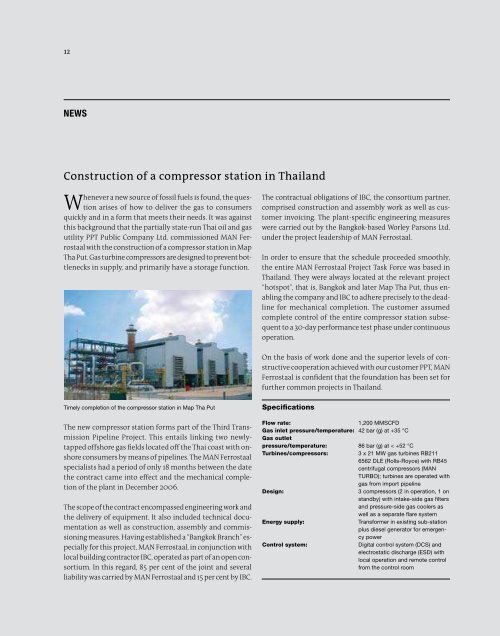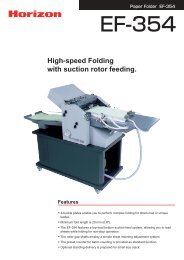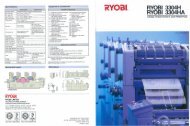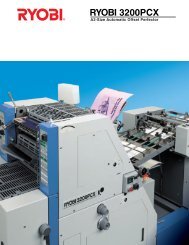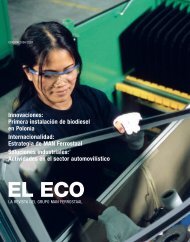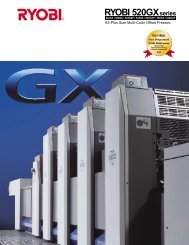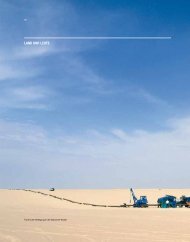THE ECHO - Ferrostaal
THE ECHO - Ferrostaal
THE ECHO - Ferrostaal
You also want an ePaper? Increase the reach of your titles
YUMPU automatically turns print PDFs into web optimized ePapers that Google loves.
12 <strong>THE</strong> <strong>ECHO</strong> August 2007<br />
13<br />
NEWS<br />
Construction of a compressor station in Thailand<br />
Whenever a new source of fossil fuels is found, the question<br />
arises of how to deliver the gas to consumers<br />
quickly and in a form that meets their needs. It was against<br />
this background that the partially state-run Thai oil and gas<br />
utility PPT Public Company Ltd. commissioned MAN <strong>Ferrostaal</strong><br />
with the construction of a compressor station in Map<br />
Tha Put. Gas turbine compressors are designed to prevent bottlenecks<br />
in supply, and primarily have a storage function.<br />
Timely completion of the compressor station in Map Tha Put<br />
The new compressor station forms part of the Third Transmission<br />
Pipeline Project. This entails linking two newlytapped<br />
offshore gas fields located off the Thai coast with onshore<br />
consumers by means of pipelines. The MAN <strong>Ferrostaal</strong><br />
specialists had a period of only 18 months between the date<br />
the contract came into effect and the mechanical completion<br />
of the plant in December 2006.<br />
The scope of the contract encompassed engineering work and<br />
the delivery of equipment. It also included technical documentation<br />
as well as construction, assembly and commissioning<br />
measures. Having established a “Bangkok Branch” especially<br />
for this project, MAN <strong>Ferrostaal</strong>, in conjunction with<br />
local building contractor IBC, operated as part of an open consortium.<br />
In this regard, 85 per cent of the joint and several<br />
liability was carried by MAN <strong>Ferrostaal</strong> and 15 per cent by IBC.<br />
The contractual obligations of IBC, the consortium partner,<br />
comprised construction and assembly work as well as customer<br />
invoicing. The plant-specific engineering measures<br />
were carried out by the Bangkok-based Worley Parsons Ltd.<br />
under the project leadership of MAN <strong>Ferrostaal</strong>.<br />
In order to ensure that the schedule proceeded smoothly,<br />
the entire MAN <strong>Ferrostaal</strong> Project Task Force was based in<br />
Thailand. They were always located at the relevant project<br />
“hotspot”, that is, Bangkok and later Map Tha Put, thus enabling<br />
the company and IBC to adhere precisely to the deadline<br />
for mechanical completion. The customer assumed<br />
complete control of the entire compressor station subsequent<br />
to a 30-day performance test phase under continuous<br />
operation.<br />
On the basis of work done and the superior levels of constructive<br />
cooperation achieved with our customer PPT, MAN<br />
<strong>Ferrostaal</strong> is confident that the foundation has been set for<br />
further common projects in Thailand.<br />
Specifications<br />
Flow rate: 1,200 MMSCFD<br />
Gas inlet pressure/temperature: 42 bar (g) at +35 °C<br />
Gas outlet<br />
pressure/temperature: 86 bar (g) at < +52 °C<br />
Turbines/compressors: 3 x 21 MW gas turbines RB211<br />
6562 DLE (Rolls-Royce) with RB45<br />
centrifugal compressors (MAN<br />
TURBO); turbines are operated with<br />
gas from import pipeline<br />
Design: 3 compressors (2 in operation, 1 on<br />
standby) with intake-side gas filters<br />
and pressure-side gas coolers as<br />
well as a separate flare system<br />
Energy supply: Transformer in existing sub-station<br />
plus diesel generator for emergency<br />
power<br />
Control system: Digital control system (DCS) and<br />
electrostatic discharge (ESD) with<br />
local operation and remote control<br />
from the control room<br />
Clean air for a radiation-free future<br />
The decommissioning of nuclear<br />
power stations means that we are<br />
faced with a difficult long-term legacy.<br />
After an operational life of 21 years, the<br />
Jülich Experimental Reactor, one of<br />
the first nuclear reactors in Germany,<br />
was finally shut down in 1988. Since<br />
then, the reactor site has gradually<br />
been returned to a greenfield state. The<br />
specially built material lock on the reactor<br />
building plays a central role in<br />
this process. It ensures the safe containment<br />
of radioactively contaminated<br />
reactor components which are<br />
sealed in the lock. The lock’s ventilation<br />
system must be steadily adapted<br />
in keeping with the decommissioning<br />
process.<br />
At the end of 2004, MAN <strong>Ferrostaal</strong><br />
won the contract from the Jülich Experimental<br />
Reactor Consortium to<br />
build new ventilation systems and a<br />
chimney flue with an activity monitoring<br />
system. The contract was worth<br />
around 2.5 million euros. The systems<br />
were delivered to the operator on<br />
schedule at the end of 2006.<br />
The new ventilation systems were deployed<br />
inside the material lock. To this<br />
end, the waste air of the new ventilation<br />
system has been merged with the<br />
rest of the plant’s waste air via parallel<br />
filtering units containing prefilters and<br />
air filters. This is then discharged into<br />
the atmosphere via a newly erected 65metre-high<br />
chimney flue.<br />
Bioshield and water tower; material lock with chimney flue<br />
The chimney flue itself is equipped<br />
with an integrated activity monitoring<br />
system. This system allows isokinetic<br />
samples to be taken and can also be<br />
used to measure the volumetric flow<br />
and continuously monitor and control<br />
the waste air for radioactive particles<br />
such as tritium or C14. MAN <strong>Ferrostaal</strong><br />
also installed all the new instrumenta-<br />
tion and control equipment for the<br />
ventilation systems. All the on-site<br />
work was carried out exclusively by<br />
personnel who had received special<br />
training in radiation protection.


